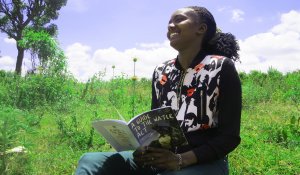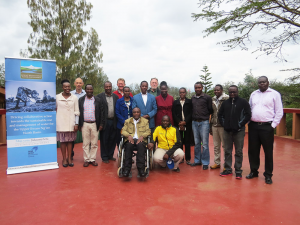Community problems can only be resolved by community-led solutions
The Mount Kenya Ewaso Water Partnership (MKEWP)–an initiative facilitated by 2030 WRG and supported by the Laikipia Wildlife Forum (LWF)–has been supporting Water Resource User Associations (WRUAs) in Kenya to manage their shared water resources. We interviewed Joy Makena, Manager of the Teleswani WRUA in Meru County, Kenya, about her experience leading her community from water conflict to collective action.

Joy Makena grew up in a farming family in Meru County, Kenya. On their family plot, her parents grew beans, maize, potatoes, and wheat. Having sufficient water for their crops was never a worry because her parents’ farm sat in the Upper Ewaso Ng’iro North Basin, which received an abundance of water from the glaciers on Mount Kenya. “During those days, the river was full. Villagers who needed to cross the river did so on bridges,” recalls Joy. Today, villagers simply wade across the river.
The receding river presents a host of problems. Each dry season, the river is reduced to a mere stream. As the number of people and animals competing for scarce water resources grows, so do tensions within the community. When pastoralists downstream struggle to find water for their cattle, they move upstream in search of increasingly scarce grazing land and water. The upward-bound cattle pass through private property, destroying crops and livelihoods. Meanwhile, smallholder farmers located downstream, believing that smallholder farmers upstream have unfairly diverted water for their crops, destroy those farmers’ irrigation canals and crops in retaliation. The conflicts that ensue sometimes result in deadly violence.
Joy was deeply troubled by such conflicts in her community. “I wanted to understand my community’s problems, from my community’s perspective. I wanted to be part of the solution,” says Joy.
She believed that community problems can only be resolved by community-led solutions and decided to join her local water resource user association (WRUA).
In Kenya, WRUAs are voluntary associations of water users legally mandated to collectively manage common water resources. They function as a kind of localized extension to the national Water Resources Authority (WRA). They are responsible for supplying people within their catchment with sufficient quantity of good quality water, especially during dry spells. This is a gargantuan task, but that is not all. WRUAs are also charged with conserving and protecting the water catchment, preserving riverine forests and the riparian ecosystem, preventing pollution of the rivers, and establishing and enforcing water-use rules.
Despite this long list of responsibilities, WRUAs suffer from chronic underfunding. Joy’s WRUA, for example, is financed exclusively by money raised through community water projects; this amount is only a fraction of what is needed. As a result, Joy’s WRUA, like many other WRUAs, are often unable to effectively monitor and regulate water usage or enforce regulations.
The Mount Kenya Ewaso Water Partnership (MKEWP)–an initiative facilitated by 2030 WRG and supported by the Laikipia Wildlife Forum (LWF)–has been working with WRUAs like Joy’s since 2016 to build their capacity and facilitate interactions between the community and government agencies.
Among many other things, MKEWP supports WRUA members to collectively inventory water-use and advocate for water management priorities within the five-year plans outlining county development goals that inform the national budgeting process. They also monitor water-use, identify illegal water abstraction in the river basin, and facilitate conflict resolution.
In March 2013, two months into her new position as her WRUA’s manager, Joy visited a group of farmers as part of a water-monitoring initiative. Thinking that Joy and her colleagues were there to take away their land, the group of farmers chased after Joy and her colleagues with their machetes. In the minds of many smallholder farmers, water and land go hand in hand. To them, any effort to curb their water use was equivalent to a threat on their land ownership. That day, Joy discovered the full extent of misinformation and distrust in the community that she would have to overcome as the manager of her WRUA.
Joy began visiting members in the community and listening to their stories. She encouraged them, even those who were hostile to her, to participate in WRUA meetings where they could openly and safely voice their concerns and learn about how they can better manage their shared water resources.
In 2017, the Upper Ewaso Ng’iro North Basin experienced an unusually long dry spell. The traditional rationing program—which called for the basin to be divided into two zones, with each zone having access to water on a two-day rotation basis—was not working. A group of people from the community stormed into Joy’s office, demanding for their share of the river’s water. “I was so scared, but I knew that I must reassure them that the WRUA will come up with a plan to ensure sufficient water supply for everyone,” Joy recalled.
Accordingly, the WRUA implemented a two-day non-abstraction period each week to help reinstate water flow. Shortly after, Joy received a call from one of the community members who had stormed into her office. Instead of threats, he simply said “Thank you, madam.”
The plan to institute a two-day non-abstraction period was a success. For the remaining period of that dry spell, everyone received the amount of water they needed and no one in the community had turned against each other. “I cannot even begin to describe the joy I felt. I have managed to do something for my community,” Joy recounts.

Joy’s hard work and courage are continuing to pay off. People in the community are showing up at WRUA meetings and are becoming savvy about water resources management. Having a space to air their grievances and listen to their neighbors’ worries enabled groups in the community to build trust and empathy and work together to solve their common water challenges. Together, members of the WRUA have already come up with a number of new community projects to better manage their shared water resources. As far as Joy knows, there have been no new conflicts.
But Joy believes that there are more opportunities to make her community more secure and peaceful. She would like to see the WRUA come up with more projects, particularly projects that can help farmers store water for use during the dry seasons. She hopes that the WRUA will become self-sustaining, and wants to get more elderly people, women, and youth interested and involved in managing their community’s water.
But Joy has another aspiration for the WRUA—she wants to see more women in leadership positions.
“Women are key to better water management. They fetch water for their families, they farm, they cook, and they clean. They understand firsthand the importance of water for the wellbeing of their families, and they have tremendous power to create lasting change,” says Joy.
She is already seeing more interest from women in the community and is confident that they will rise to the challenges that stand in the way water security in their community.
To take Joy one step closer to her aspirations for her WRUA, MKEWP is in the process of piloting a Water Resource User Association (WRUA) Agency model as a mechanism to effectively finance and capacitate WRUAs to work together with WRA, serving as agents on the ground to ensure equitable and effective management of water resources at the basin level.
